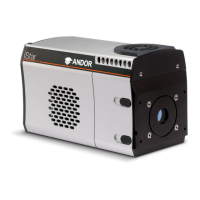Appendix
INTERNAL REFLECTION IN THE INPUT WINDOW
Data acquired from ICCDs with a 25 mm intensier tube may exhibit an artifact due to light that has entered the camera
obliquely and has been internally reected in the input window. The effect is generally not signicant, but a brief
explanation may be appropriate nonetheless.
At the center of the photocathode the internally reected rays may coincide with each other and with light falling on
the photocathode directly. The result is a signal around 5% higher than average at the center of the photocathode. The
phenomenon appears as a slight peak in the middle of a 2D trace, or as a slight cone in the middle of an image.
The aperture in the faceplate is left deliberately large to fully accommodate the light cone from lenses and
spectrographs. If an aperture of 25-26 mm diameter is placed in front of the input window, the range of angles at which
light can enter is reduced and the peak or cone effect disappears. There may then, however, be a vignette effect as light
from the outside of the light cone emerging from lenses or spectrographs is blocked.
Figure X: Internal reection in the Intensier input window.

